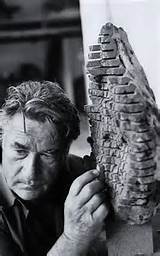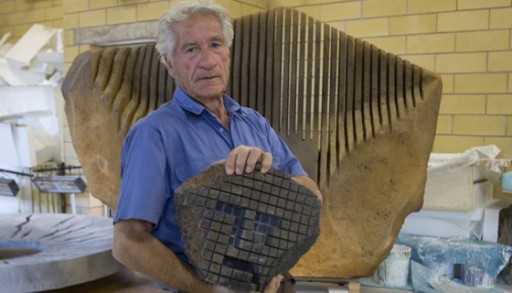
There’s a pact between Pinuccio Sciola and the stones of Sardinia, so much so that they resemble each other like two peas in a pod. This must be the reason why stones would let him do anything to them: cut them, perforate them, splinter them. He even manages to make them sing.(Renzo Piano)
Matter and dream, monumentality and lightness, sculpture and music. Pinuccio Sciola, in yourTurandot everything seems to revolve around the contrast between immaterial elements such as singing and miming, the videos and the impressive architectures of your stones…
For centuries it has been thought that stone is tough, stiff, full of negativity, silent, blank. Indeed – if I beat it – what I hear is just the sound of the stone being beaten, I can’t get a sound from its inside. But the stone has a soul, a memory guarding the history of humankind. The first paragraph of Genesis tells us that «first of all there was the sound of the Universe». Evidently those sounds, that memory, that genetic code left a sediment inside the stone, which guards them like a coffer. I remind the sceptics that all information spread by computers and digital networks today is, after all, guarded and developed through infinitesimal silicon crystals.
Let’s take a common stone as, for example, limestone. If I make it vibrate with my hands, it emits liquid sounds: simply because limestone, from a geological point of view, is nothing else but fossilized water. It is as if the memory of the matter water was trapped during glaciation within this rock, and only by caressing it the sound comes out. The same happens with the basalt of volcanic origin. If I “play” and stimulate with my hands one of my basalt sculptures, it gives me back its soul of fire and earth. There will never be two identical stones, because in every kind of stone and in every single little square that I carved upon their surface the sound propagates in a different way and tells us a different story.
In this case my sculptures give life to a real architecture, which is visual, theatrical and musical at the same time, a sonic city where the events of Turandot take place. This isn’t my first experience in set design, even though I have never ventured upon opera before. Working for Cagliari opera house is a special opportunity, which makes me particularly happy and proud. Actually, the place where I work, my workshop and my garden in San Sperate, resemble very much to a set design. And my works were created in the middle of nature set. What is really exciting in this experience is that, thanks to the extraordinary abilities and to the experience of the people working there, we were able to recreate my sculptures gigantic size in the Teatro Lirico workshop, using scenic materials different from stone and making them become architectural elements of a fantastical city. This Turandot conveys a strong ancestral mark of Sardinia, and, at the same time, manages to reinterpret a contemporary, even somewhat futuristic, Beijing. We tried to imagine that the events took place far away but, at the same time, close at hand. Well… it is as if the Princess’s heart, as well as the music, were pent up in stone. And could be released only thanks to love. Just as it happens when I let my sculptures sound by caressing them.
In this case the size of Turandot’s petrified city isn’t precisely on a caress scale…
During the developing of the scenery, I was moved at seeing my sculptures, which are in themselves not so small, be built on a gigantic. In Turandot , the architectural elements of my sonic cities will be almost 15 metres high, the height of a real 5-storey building. It is a big thrill that I want to share with the public. For this reason, I resolved to place some imposing scenic elements right from the opera house outside and the foyer, two big buildings, whose loftiness can make the spectators feel, even before the opera begins, like being wrapped from the stone architectures, so becoming a part of an unexpected vibrant sensory experience. I tried to go beyond the scenic convention of the stage as a black rectangle, inside which all the scene develops and scenic and visual elements of the show condense. As the Theatre is an integral part of the city and the city itself is an extraordinary natural theatre, ienvisaged that these fantastical architectures may occupy and characterize the urban space.
Finally, I hope that this Turandot will be especially appreciated for the extraordinary teamwork which led to its fulfilment. I must say that, right from the beginning, there has been a perfect understanding, a wonderful exchange of creativity and passion, with director Pier Francesco Maestrini and with costume designer Marco Nateri. All different steps of this Turandot staging were amazing, thanks to the talent and professionalism of the people who work in the Teatro Lirico set design workshops, under the guidance of Sabrina Cuccu. You can have the best ideas in the world, but if you don’t have the manual skill, the different competences and sensibilities of the people who must practically implement them, you can’t achieve a result like this. Obvously, it isn’t the first time for the Teatro Lirico non è la prima volta, since high quality stagings are constantly being created here, and there is a unique quality standard. But I like to think that what we’ve fulfilled together during these months is something really unique.
The sound of the stones is the same sound of human voice: the only one which comes directly from nature, if you naturally allow it. The voice is modulated by men, by women; the stone is worked by Sciola to sound. But there isn’t, in both cases, a transformation of the material, wood or iron, in an otherwise nonexistent sounding form, as it is as for musical instruments. So the sound of Sciola’s stones is directly a part of the soundscape, just as the voice is.(Luigi Pestalozza)
http://www.teatroliricodicagliari.it/en/news/pinucciosciola.html

